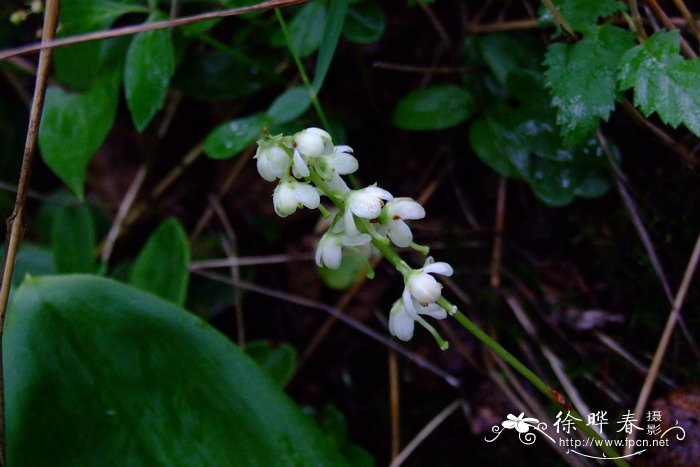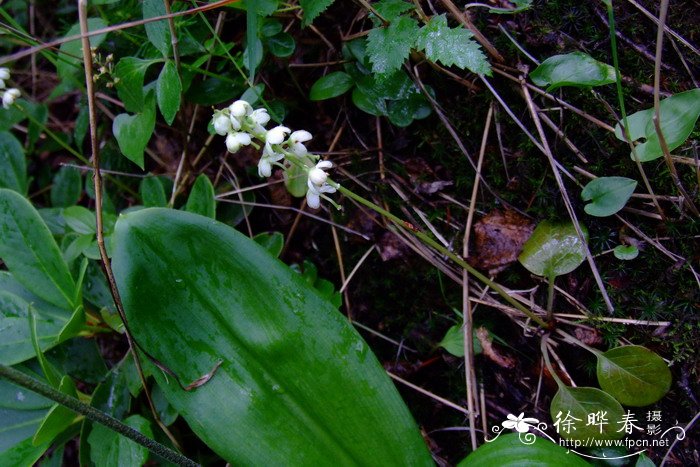圆叶鹿蹄草Pyrola rotundifolia
中文名(Chinese Name):圆叶鹿蹄草
学名(Scientific Name):Pyrola rotundifolia Linn.
英文名(English Common Name):
别名(Chinese Common Name):鹿蹄草
异名(Synonym):Thelaia rotundifolia (L.) Alef.
科属(Family & Genus):鹿蹄草科(Pyrolaceae)鹿蹄草属
形态特征(Description):常绿草本状小半灌木,高15-25(-30)厘米;根茎细长,横生,斜升,有分枝。叶4-7,基生,革质,稍有光泽,圆形或圆卵形,长(2-) 3-6厘米,宽(1.5)2.5-5.5厘米,先端圆钝,基部圆形至圆截形,有时稍心形,边缘有不明显的疏圆齿或近全缘,上面绿色,下面色稍淡;叶柄长约为叶片之2倍或近等长。花葶有1-2枚褐色鳞片状叶,长椭圆状卵形,长8-10(-12)毫米,宽3-5毫米,先端,急尖,基部稍抱花葶。总状花序长6-13(-16)厘米,有(6-)8-15(-18)花,花倾斜,稍下垂,花冠广开,直径1.5-2厘米,白色;花梗长4.5-5毫米,腋间有膜质苞片,披针形,长4.6-5毫米,宽1.8-2.1毫米,与花梗近等长或稍长;萼片狭披针形,长3.5-5.5毫米,长为宽的3-3.5倍,约为花瓣之半,先端渐尖或长渐尖,边缘全缘;花瓣倒圆卵形,长6-10毫米,宽4-6毫米,先端圆钝;雄蕊10,花丝无毛,花药具小角,黄色;花柱长7.5-10毫米,倾斜,上部向上弯曲,伸出花冠,顶端有明显的环状突起,柱头5浅圆裂。蒴果扁球形,高(4-)4.5-5毫米,直径(6-)7-8毫米。花期6-7月;果期8-9月。
分布(Distribution):产新疆,生于海拔1000-2000米的山地针叶林、针阔叶混交林或阔叶林下。蒙古、俄罗斯、欧洲为其分布中心。
引自中国植物志英文版:FOC Vol. 14 Page 253
Pyrola rotundifolia Linnaeus, Sp. Pl. 1: 396. 1753.
圆叶鹿蹄草 yuan ye lu ti cao| Ericaceae | Pyrola
Thelaia rotundifolia (Linnaeus) Alefeld.
Herbs 15–25(–30) cm tall. Rhizome long, slender, branched, producing adventitious roots and aerial stems at nodes; aerial stems 15–30 cm, ribbed, with a basal rosette of crowded leaves, and higher up with 1 or 2 oblong-ovate sheathing, scalelike, brownish bracts. Rosulate leaves 4–7, semievergreen; petiole ca. 2 × or ca. as long as blades; leaf blade slightly green abaxially, green adaxially, slightly shiny, orbicular to ovate, (2–)3–6 × (1.5–)2.5–5.5 cm, leathery, base sometimes subcordate, margin obscurely crenate or nearly entire, apex rounded. Rachis-inserted scale-shaped leaves 1 or 2; raceme 8–15-flowered, 6–16 cm. Pedicel 4.5–5 mm; bracts axillary, imbricate, lanceolate, membranous. Flowers spreading or rarely nodding, 1.5–2 cm in diam., widely opened, fragrant (scent of Convallaria majalis Linnaeus). Sepals ovate-lanceolate to lanceolate, 3.5–5.5 mm, reflexed at tip, apex rounded. Petals incurved, pure white, orbicular-ovate, 6.5–10 × 4–6 mm, rather thick, apex obtuse. Stamens arched toward upper side of flower; filaments glabrous, anthers yellow, tubules present. Style 7.5–10 mm, deflexed at base and facing lower part of corolla, dilated at apex into a ring. Capsule (6–)7–8 mm in diam. Fl. Jun–Jul, fr. unknown.
Picea forests, mountain thickets, grassy slopes; 1400–3200 m. Gansu, ?Hebei, ?Jiangsu, ?Liaoning, ?Ningxia, ?Shaanxi, Sichuan, N Xinjiang (Altay), Xizang, Yunnan [Japan, Mongolia, Myanmar, Russia; Europe].
According to Haber (Syst. Bot. 8: 277–298. 1983), one of the main areas of taxonomic difficulty in Pyrola occurs in P. sect. Pyrola (see Křísa, Bot. Jahrb. Syst. 90: 476–508. 1971, for sectional subdivisions). The type of the section is P. rotundifolia Linnaeus, a white-flowered species common throughout Europe and eastward to just beyond Lake Baikal in Siberia (cf. Hultén, Amphi-Atlantic Pl. map 123. 1958). Numerous taxa, both white- and pink-flowered, have been recognized as segregates of this widespread species, or described as distinct but related to P. rotundifolia. The assessment of taxonomic affinities within this “complex” has been problematic because of the lack of clear morphological discontinuities (Haber & Takahashi, Bot. Mag. (Tokyo) 101: 483–495).


(责任编辑:徐晔春)
学名(Scientific Name):Pyrola rotundifolia Linn.
英文名(English Common Name):
别名(Chinese Common Name):鹿蹄草
异名(Synonym):Thelaia rotundifolia (L.) Alef.
科属(Family & Genus):鹿蹄草科(Pyrolaceae)鹿蹄草属
形态特征(Description):常绿草本状小半灌木,高15-25(-30)厘米;根茎细长,横生,斜升,有分枝。叶4-7,基生,革质,稍有光泽,圆形或圆卵形,长(2-) 3-6厘米,宽(1.5)2.5-5.5厘米,先端圆钝,基部圆形至圆截形,有时稍心形,边缘有不明显的疏圆齿或近全缘,上面绿色,下面色稍淡;叶柄长约为叶片之2倍或近等长。花葶有1-2枚褐色鳞片状叶,长椭圆状卵形,长8-10(-12)毫米,宽3-5毫米,先端,急尖,基部稍抱花葶。总状花序长6-13(-16)厘米,有(6-)8-15(-18)花,花倾斜,稍下垂,花冠广开,直径1.5-2厘米,白色;花梗长4.5-5毫米,腋间有膜质苞片,披针形,长4.6-5毫米,宽1.8-2.1毫米,与花梗近等长或稍长;萼片狭披针形,长3.5-5.5毫米,长为宽的3-3.5倍,约为花瓣之半,先端渐尖或长渐尖,边缘全缘;花瓣倒圆卵形,长6-10毫米,宽4-6毫米,先端圆钝;雄蕊10,花丝无毛,花药具小角,黄色;花柱长7.5-10毫米,倾斜,上部向上弯曲,伸出花冠,顶端有明显的环状突起,柱头5浅圆裂。蒴果扁球形,高(4-)4.5-5毫米,直径(6-)7-8毫米。花期6-7月;果期8-9月。
分布(Distribution):产新疆,生于海拔1000-2000米的山地针叶林、针阔叶混交林或阔叶林下。蒙古、俄罗斯、欧洲为其分布中心。
引自中国植物志英文版:FOC Vol. 14 Page 253
Pyrola rotundifolia Linnaeus, Sp. Pl. 1: 396. 1753.
圆叶鹿蹄草 yuan ye lu ti cao| Ericaceae | Pyrola
Thelaia rotundifolia (Linnaeus) Alefeld.
Herbs 15–25(–30) cm tall. Rhizome long, slender, branched, producing adventitious roots and aerial stems at nodes; aerial stems 15–30 cm, ribbed, with a basal rosette of crowded leaves, and higher up with 1 or 2 oblong-ovate sheathing, scalelike, brownish bracts. Rosulate leaves 4–7, semievergreen; petiole ca. 2 × or ca. as long as blades; leaf blade slightly green abaxially, green adaxially, slightly shiny, orbicular to ovate, (2–)3–6 × (1.5–)2.5–5.5 cm, leathery, base sometimes subcordate, margin obscurely crenate or nearly entire, apex rounded. Rachis-inserted scale-shaped leaves 1 or 2; raceme 8–15-flowered, 6–16 cm. Pedicel 4.5–5 mm; bracts axillary, imbricate, lanceolate, membranous. Flowers spreading or rarely nodding, 1.5–2 cm in diam., widely opened, fragrant (scent of Convallaria majalis Linnaeus). Sepals ovate-lanceolate to lanceolate, 3.5–5.5 mm, reflexed at tip, apex rounded. Petals incurved, pure white, orbicular-ovate, 6.5–10 × 4–6 mm, rather thick, apex obtuse. Stamens arched toward upper side of flower; filaments glabrous, anthers yellow, tubules present. Style 7.5–10 mm, deflexed at base and facing lower part of corolla, dilated at apex into a ring. Capsule (6–)7–8 mm in diam. Fl. Jun–Jul, fr. unknown.
Picea forests, mountain thickets, grassy slopes; 1400–3200 m. Gansu, ?Hebei, ?Jiangsu, ?Liaoning, ?Ningxia, ?Shaanxi, Sichuan, N Xinjiang (Altay), Xizang, Yunnan [Japan, Mongolia, Myanmar, Russia; Europe].
According to Haber (Syst. Bot. 8: 277–298. 1983), one of the main areas of taxonomic difficulty in Pyrola occurs in P. sect. Pyrola (see Křísa, Bot. Jahrb. Syst. 90: 476–508. 1971, for sectional subdivisions). The type of the section is P. rotundifolia Linnaeus, a white-flowered species common throughout Europe and eastward to just beyond Lake Baikal in Siberia (cf. Hultén, Amphi-Atlantic Pl. map 123. 1958). Numerous taxa, both white- and pink-flowered, have been recognized as segregates of this widespread species, or described as distinct but related to P. rotundifolia. The assessment of taxonomic affinities within this “complex” has been problematic because of the lack of clear morphological discontinuities (Haber & Takahashi, Bot. Mag. (Tokyo) 101: 483–495).
(责任编辑:徐晔春)
踩一下[0]

顶一下[0]